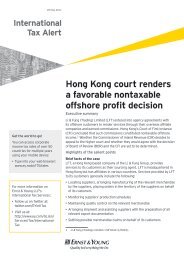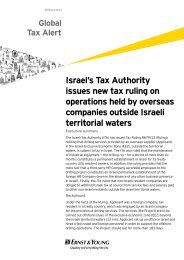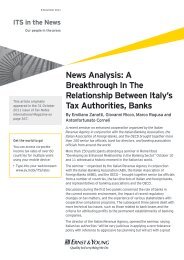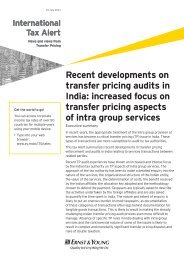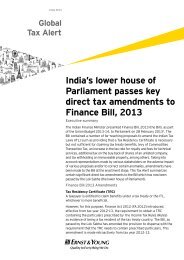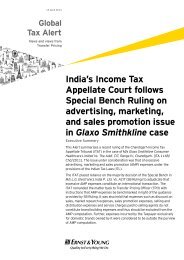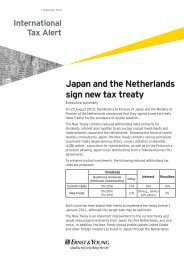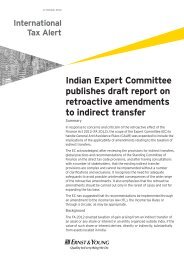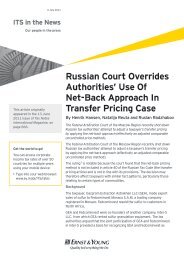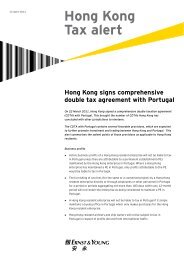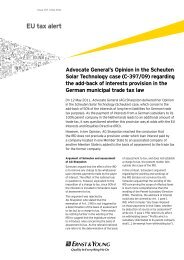M&A Transactions in Singapore - Ernst & Young T Magazine
M&A Transactions in Singapore - Ernst & Young T Magazine
M&A Transactions in Singapore - Ernst & Young T Magazine
Create successful ePaper yourself
Turn your PDF publications into a flip-book with our unique Google optimized e-Paper software.
3 November 2010<br />
ITS <strong>in</strong> the News<br />
Our people <strong>in</strong> the press<br />
This article orig<strong>in</strong>ally appeared<br />
<strong>in</strong> the 4 October 2010 issue<br />
of Tax Notes International<br />
Magaz<strong>in</strong>e on page 45.<br />
M&A <strong>Transactions</strong> <strong>in</strong><br />
S<strong>in</strong>gapore<br />
By Ch<strong>in</strong>g Khee Tan and Pui M<strong>in</strong>g Soh<br />
Ch<strong>in</strong>g Khee Tan and Pui M<strong>in</strong>g Soh exam<strong>in</strong>e the key issues surround<strong>in</strong>g<br />
mergers and acquisitions transactions <strong>in</strong> S<strong>in</strong>gapore. Ch<strong>in</strong>g Khee Tan is a<br />
senior manager of the S<strong>in</strong>gapore tax desk at <strong>Ernst</strong> & <strong>Young</strong> LLP <strong>in</strong> New<br />
York, and Pui M<strong>in</strong>g Soh is a tax partner and leader of transaction tax at<br />
<strong>Ernst</strong> & <strong>Young</strong> <strong>in</strong> S<strong>in</strong>gapore. The views expressed here are those of the<br />
authors and do not necessarily reflect those of <strong>Ernst</strong> & <strong>Young</strong> LLP.<br />
Through June 2010, S<strong>in</strong>gapore’s economy grew by a stagger<strong>in</strong>g<br />
17.9 percent, and the outlook for S<strong>in</strong>gapore and other grow<strong>in</strong>g Asian<br />
economies, such as Ch<strong>in</strong>a and India, rema<strong>in</strong>s positive for the rest of 2010.<br />
Investor <strong>in</strong>terest <strong>in</strong> S<strong>in</strong>gapore is buoyant because companies often base<br />
their regional operations <strong>in</strong> S<strong>in</strong>gapore because of its proximity to other<br />
Asian countries, excellent bus<strong>in</strong>ess <strong>in</strong>frastructure, and good tax treaty<br />
network.<br />
This article highlights key S<strong>in</strong>gaporean tax issues on merger and<br />
acquisition transactions and is organized <strong>in</strong>to three sections: deal<br />
structure, postacquisition considerations, and recent tax developments<br />
affect<strong>in</strong>g M&A activities <strong>in</strong> S<strong>in</strong>gapore.<br />
Deal Structure<br />
Buyers generally prefer an asset acquisition because it avoids the<br />
assumption of the target company’s tax or other liabilities, <strong>in</strong>clud<strong>in</strong>g<br />
uncerta<strong>in</strong> or aggressive tax positions. An asset acquisition also:<br />
• allows a step-up of the depreciable base for fixed assets to their fair<br />
market values; and<br />
• facilitates the claim for an <strong>in</strong>terest expense deduction on debt raised to<br />
f<strong>in</strong>ance the acquisition.
However, for some buyers, an asset<br />
acquisition is not the best choice.<br />
For example, <strong>in</strong> acquir<strong>in</strong>g a target<br />
whose major asset is real estate,<br />
the 1 to 3 percent S<strong>in</strong>gaporean<br />
stamp duty for real estate transfers<br />
is 5 to 15 times more than that<br />
for the transfer of shares. Also,<br />
commercial considerations, such<br />
as special <strong>in</strong>dustry licenses and/or<br />
regulatory approval, or favorable<br />
tax attributes of the target company<br />
(for example, tax <strong>in</strong>centives) may<br />
sw<strong>in</strong>g the balance toward a share<br />
acquisition.<br />
Most importantly, many sellers<br />
are not <strong>in</strong>terested <strong>in</strong> asset deals<br />
because they perceive them to<br />
be legally and adm<strong>in</strong>istratively<br />
cumbersome. In countries where<br />
there is tax on capital ga<strong>in</strong>s, an<br />
asset deal may be more expensive<br />
than a share deal from a seller’s tax<br />
perspective.<br />
Before enter<strong>in</strong>g <strong>in</strong>to a deal, the<br />
buyer should understand the<br />
tax implications and develop an<br />
acquisition plan that meets both<br />
its needs and the seller’s needs.<br />
A w<strong>in</strong>-w<strong>in</strong> acquisition structure<br />
can put the buyer ahead of other<br />
bidders <strong>in</strong> a competitive bid<br />
situation. Antiavoidance provisions<br />
should be taken <strong>in</strong>to account <strong>in</strong> all<br />
plann<strong>in</strong>g. There should be bona fide<br />
commercial reasons for enter<strong>in</strong>g<br />
<strong>in</strong>to any transaction.<br />
For any M&A transaction <strong>in</strong><br />
S<strong>in</strong>gapore, the buyer should<br />
consider the plann<strong>in</strong>g opportunities<br />
on <strong>in</strong>terest that will be <strong>in</strong>curred on<br />
the acquisition and the <strong>in</strong>tellectual<br />
property (IP) that will be acquired.<br />
Interest Deduction<br />
In S<strong>in</strong>gapore, <strong>in</strong>terest <strong>in</strong>curred on<br />
the acquisition of shares is not tax<br />
deductible, which could significantly<br />
affect the after-tax return on the<br />
<strong>in</strong>vestment.<br />
A well-structured debt push-down<br />
strategy can significantly <strong>in</strong>crease<br />
the return on <strong>in</strong>vestment, especially<br />
when the target group is located<br />
<strong>in</strong> a number of jurisdictions. Under<br />
this strategy, appropriate amounts<br />
of the acquisition debt are pushed<br />
down to locations generat<strong>in</strong>g<br />
operat<strong>in</strong>g profits to obta<strong>in</strong> a tax<br />
deduction for the <strong>in</strong>terest expense<br />
aga<strong>in</strong>st local profits, which could<br />
be taxed at high corporate tax<br />
rates. This strategy also facilitates<br />
cash repatriation for repayment of<br />
bridge f<strong>in</strong>anc<strong>in</strong>g and/or part of the<br />
acquisition debt. However, there are<br />
many factors to consider, <strong>in</strong>clud<strong>in</strong>g<br />
local withhold<strong>in</strong>g tax provisions,<br />
th<strong>in</strong> capitalization rules, and debt<br />
registration requirements.<br />
IP Plann<strong>in</strong>g<br />
Another important step <strong>in</strong> unlock<strong>in</strong>g<br />
additional return value from the<br />
target is IP plann<strong>in</strong>g.<br />
Often the value of the acquired<br />
bus<strong>in</strong>ess is <strong>in</strong> the IP. Share<br />
acquisition, however, does not allow<br />
the buyer to claim tax amortization<br />
on the step-up IP acquired <strong>in</strong><br />
S<strong>in</strong>gapore. S<strong>in</strong>gapore’s <strong>in</strong>come tax<br />
law does not allow the buyer to step<br />
up the tax basis of the assets <strong>in</strong> the<br />
target to reflect the purchase price<br />
of the shares acquired. Therefore,<br />
the buyer should consider a<br />
2 ITS <strong>in</strong> the News Our people <strong>in</strong> the press<br />
two-step approach of first acquir<strong>in</strong>g<br />
the IP directly from the seller and<br />
then the shares <strong>in</strong> the target group.<br />
Postacquisition Considerations<br />
The postacquisition tax work is<br />
probably the most neglected area<br />
<strong>in</strong> the acquisition process. After the<br />
acquisition, it is important for the<br />
acquir<strong>in</strong>g company to monitor tax<br />
<strong>in</strong>demnities and warranties, and<br />
manage tax exposures.<br />
Monitor<strong>in</strong>g Tax Indemnities and<br />
Warranties<br />
The sale and purchase agreement<br />
(SPA) usually provides that the<br />
buyer must notify the seller of<br />
all tax claims with<strong>in</strong> a certa<strong>in</strong> tax<br />
period (typically two to four years<br />
from the date of the SPA).<br />
Usually, buyers do not monitor<br />
this to take full advantage of the<br />
<strong>in</strong>demnity period. A savvy buyer<br />
should give clear <strong>in</strong>structions to<br />
its <strong>in</strong>-house tax team to expedite<br />
the f<strong>in</strong>alization of the prior years’<br />
tax returns to br<strong>in</strong>g any tax claims<br />
to the surface before the tax<br />
<strong>in</strong>demnity expires.<br />
Manag<strong>in</strong>g Tax Exposures<br />
A good way to manage exist<strong>in</strong>g<br />
tax exposures is through the<br />
due diligence report. Follow-ups<br />
<strong>in</strong>clude meet<strong>in</strong>g withhold<strong>in</strong>g tax<br />
obligations, putt<strong>in</strong>g <strong>in</strong> place transfer<br />
pric<strong>in</strong>g documentation, reexam<strong>in</strong><strong>in</strong>g<br />
and possibly renegotiat<strong>in</strong>g<br />
commercial contracts regard<strong>in</strong>g tax<br />
gross-up clauses, and address<strong>in</strong>g<br />
permanent establishment issues<br />
with appropriate secondment<br />
arrangements.
Recent Tax Developments<br />
A new tax framework for<br />
amalgamation and an <strong>in</strong>creased<br />
focus on economic substance <strong>in</strong><br />
Asia may affect how M&A deals <strong>in</strong><br />
S<strong>in</strong>gapore are structured.<br />
Tax Framework for<br />
Amalgamation<br />
The ability to restructure and<br />
<strong>in</strong>tegrate the various operations<br />
<strong>in</strong> a tax-efficient manner after<br />
acquisition will be crucial to the<br />
buyer.<br />
New rules on the tax framework<br />
for amalgamation were enacted<br />
<strong>in</strong> December 2009 and apply<br />
retrospectively to amalgamation<br />
that takes place on or after January<br />
22, 2009. An amalgamation is the<br />
merger of two or more companies<br />
<strong>in</strong>to a s<strong>in</strong>gle company. The surviv<strong>in</strong>g<br />
company assumes the assets,<br />
rights, liabilities, and obligations of<br />
the other amalgamat<strong>in</strong>g companies.<br />
The latter are then automatically<br />
dissolved by operation of law.<br />
Some of the benefits and<br />
considerations under the new tax<br />
framework <strong>in</strong>clude:<br />
• Transfer of unused tax attributes:<br />
Unused tax attributes, such as tax<br />
losses, may be transferred from<br />
the amalgamat<strong>in</strong>g company to<br />
the surviv<strong>in</strong>g company, subject to<br />
conditions.<br />
• Deferral of tax depreciation<br />
recapture: Tax depreciation<br />
previously claimed on the IP,<br />
plant, and mach<strong>in</strong>ery will not be<br />
immediately recaptured on the<br />
transfer of such assets from the<br />
amalgamat<strong>in</strong>g company to the<br />
surviv<strong>in</strong>g company. The surviv<strong>in</strong>g<br />
company will claim the tax<br />
depreciation based on the<br />
rema<strong>in</strong><strong>in</strong>g tax base carried over<br />
(that is, no step-up <strong>in</strong> value).<br />
Recapture of tax depreciation<br />
will be triggered if the assets are<br />
subsequently disposed of by the<br />
surviv<strong>in</strong>g company.<br />
• Exemption from goods and<br />
services tax: The amalgamation<br />
will automatically qualify as a<br />
transfer of the bus<strong>in</strong>ess as a<br />
go<strong>in</strong>g concern such that GST will<br />
not be chargeable on the assets<br />
transferred, unless the surviv<strong>in</strong>g<br />
company is a member of a GST<br />
consolidated group.<br />
• Stamp duty relief: Unlike GST,<br />
there is no automatic exemption<br />
from stamp duty when the<br />
transferred assets are dutiable<br />
assets. Nevertheless, exemption<br />
from stamp duty is available if<br />
the stamp duty relief rules can be<br />
met. Detailed discussion of the<br />
rules<br />
is beyond the scope of this article.<br />
Increased Focus on Economic<br />
Substance <strong>in</strong> Asia<br />
Foreign <strong>in</strong>vestors commonly set up<br />
a S<strong>in</strong>gaporean hold<strong>in</strong>g company<br />
to manage its Asian <strong>in</strong>vestments<br />
for operational, f<strong>in</strong>ancial, and<br />
tax efficiency reasons. In an M&A<br />
situation, the buyer could:<br />
• use its exist<strong>in</strong>g S<strong>in</strong>gaporean<br />
subsidiary to acquire the target;<br />
• <strong>in</strong>corporate a new S<strong>in</strong>gaporean<br />
subsidiary to acquire the target;<br />
or<br />
ITS <strong>in</strong> the News Our people <strong>in</strong> the press<br />
• <strong>in</strong>herit the S<strong>in</strong>gaporean hold<strong>in</strong>g<br />
company structure from the<br />
seller.<br />
Tax authorities <strong>in</strong> Ch<strong>in</strong>a, India,<br />
Indonesia, and South Korea<br />
are focus<strong>in</strong>g on the use of an<br />
<strong>in</strong>termediate hold<strong>in</strong>g company.<br />
The tax authorities often perceive<br />
<strong>in</strong>termediate hold<strong>in</strong>g companies<br />
as lack<strong>in</strong>g economic substance<br />
and as be<strong>in</strong>g created merely to<br />
take advantage of treaty benefits.<br />
The tax authorities have sought to<br />
curb such perceived treaty abuse<br />
through various countermeasures<br />
to determ<strong>in</strong>e the beneficial<br />
ownership and economic substance<br />
of such <strong>in</strong>termediate hold<strong>in</strong>g<br />
companies. In S<strong>in</strong>gapore, it is<br />
gett<strong>in</strong>g more difficult to obta<strong>in</strong><br />
a certificate of residency from<br />
the tax authorities for <strong>in</strong>active,<br />
foreign-owned S<strong>in</strong>gaporean hold<strong>in</strong>g<br />
companies.<br />
Foreign <strong>in</strong>vestors with an<br />
<strong>in</strong>termediate hold<strong>in</strong>g company<br />
structure for its Asian <strong>in</strong>vestments<br />
(us<strong>in</strong>g S<strong>in</strong>gapore or otherwise)<br />
should reevaluate the hold<strong>in</strong>g<br />
company’s relevance and take<br />
active steps to ensure that the<br />
structure can withstand scrut<strong>in</strong>y by<br />
the tax authorities. For example,<br />
theS<strong>in</strong>gaporean hold<strong>in</strong>g company<br />
could be amalgamated with its<br />
S<strong>in</strong>gaporean operat<strong>in</strong>g subsidiary.<br />
Not only will there be <strong>in</strong>creased<br />
operational efficiencies, but<br />
hav<strong>in</strong>g an active bus<strong>in</strong>ess and key<br />
employees will reduce the risk of<br />
the hold<strong>in</strong>g company be<strong>in</strong>g viewed<br />
as lack<strong>in</strong>g <strong>in</strong> substance.<br />
3
Conclusion<br />
When <strong>in</strong>vest<strong>in</strong>g <strong>in</strong> S<strong>in</strong>gapore and the region, foreign <strong>in</strong>vestors should plan carefully. With tax authorities turn<strong>in</strong>g<br />
their attention to economic substance, it is <strong>in</strong>creas<strong>in</strong>gly important that any acquisition or restructur<strong>in</strong>g option<br />
adopted is aligned with bus<strong>in</strong>ess and commercial objectives, and not for the sole purpose of obta<strong>in</strong><strong>in</strong>g a tax<br />
advantage.<br />
For additional <strong>in</strong>formation with respect to this ITS <strong>in</strong> the News, please contact the<br />
follow<strong>in</strong>g:<br />
<strong>Ernst</strong> & <strong>Young</strong> LLP, S<strong>in</strong>gapore Tax Desk, New York<br />
• Ch<strong>in</strong>g Khee Tan +1 212 773 0012 ch<strong>in</strong>gkhee.tan@ey.com<br />
<strong>Ernst</strong> & <strong>Young</strong>, S<strong>in</strong>gapore<br />
• Pui M<strong>in</strong>g Soh +65 6309 8215 pui.m<strong>in</strong>g.soh@sg.ey.com<br />
4 ITS <strong>in</strong> the News Our people <strong>in</strong> the press
International Tax Services<br />
• Global ITS, Jim Tob<strong>in</strong>, New York<br />
• Americas, Jeffrey Michalak, Detroit<br />
• Asia Pacific, Alice Chan, Shanghai<br />
• Europe, Middle East, India and Africa, Alex Postma, London<br />
• Japan, Kai Hielscher, Tokyo<br />
• Lat<strong>in</strong> America, Alberto Lopez, New York<br />
• Argent<strong>in</strong>a Carlos Casanovas Buenos Aires<br />
• Australia Daryn Moore Sydney<br />
• Austria Roland Rief Vienna<br />
• Belgium Herwig Joosten Brussels<br />
• Brazil Gil Mendes Sao Paulo<br />
• Canada George Guedikian Toronto<br />
• Central America Rafael Sayagues San José<br />
• Chile Osiel Gonzalez Santiago<br />
• Ch<strong>in</strong>a Becky Lai Beij<strong>in</strong>g<br />
• Colombia Ximena Zuluaga Bogota<br />
• Czech Republic Libor Frýzek Prague<br />
• Denmark Niels Josephsen Soborg<br />
• F<strong>in</strong>land Katri Nygård Hels<strong>in</strong>ki<br />
• France Claire Acard Paris<br />
Régis Houriez Paris<br />
• Germany Stefan Koehler Frankfurt<br />
• Hong Kong Chris F<strong>in</strong>nerty Hong Kong<br />
• Hungary Botond Rencz Budapest<br />
Balazs Szolgyemy Budapest<br />
• India Vijay Iyer Bangalore<br />
• Ireland Kev<strong>in</strong> McLoughl<strong>in</strong> Dubl<strong>in</strong><br />
• Israel Sharon Shulman Tel Aviv<br />
• Italy Mario Ferrol Milan<br />
Gaetano Pizzitola Rome<br />
• Japan Kai Hielscher Tokyo<br />
• Korea Kyung-Tae Ko Seoul<br />
• Luxembourg Frank Muntendam Luxembourg<br />
• Malaysia Hock Khoon Lee Kuala Lumpur<br />
• Mexico Koen van ‘t Hek Mexico City<br />
• Middle East Tobias L<strong>in</strong>tvelt Abu Dhabi<br />
• Middle East Michelle Kotze Dubai<br />
• Netherlands Johan van den Bos Amsterdam<br />
• Norway Oyv<strong>in</strong>d Hovland Oslo<br />
• Peru Roberto Cores Lima<br />
• Philipp<strong>in</strong>es Ma Fides Balili Makati City<br />
• Poland Lukasz Ziolek Warsaw<br />
• Portugal Antonio Neves Lisbon<br />
• Russia Vladimir Zheltonogov Moscow<br />
• S<strong>in</strong>gapore Andy Baik S<strong>in</strong>gapore<br />
• South Africa Corlie Hazell Johannesburg<br />
• Spa<strong>in</strong> Federico L<strong>in</strong>ares Madrid<br />
• Sweden Erik Hultman Stockholm<br />
• Switzerland Markus F. Huber Zurich<br />
• Taiwan Jennifer Williams Taipei<br />
• Thailand Anthony Loh Bangkok<br />
• Turkey Feridun Gungor Istanbul<br />
• United K<strong>in</strong>gdom Matthew Mealey London<br />
Jim Charlton London<br />
• United States Jeffrey Michalak Detroit<br />
• Venezuela Jose Velazquez Caracas<br />
• Vietnam Carlos Llanes Navarro Bogota<br />
ITS <strong>in</strong> the News Our people <strong>in</strong> the press<br />
<strong>Ernst</strong> & <strong>Young</strong><br />
Assurance | Tax | <strong>Transactions</strong> | Advisory<br />
About <strong>Ernst</strong> & <strong>Young</strong><br />
<strong>Ernst</strong> & <strong>Young</strong> is a global leader <strong>in</strong><br />
assurance, tax, transaction and advisory<br />
services. Worldwide, our 141,000 people<br />
are united by our shared values and an<br />
unwaver<strong>in</strong>g commitment to quality. We<br />
make a difference by help<strong>in</strong>g our people,<br />
our clients and our wider communities<br />
achieve their potential.<br />
<strong>Ernst</strong> & <strong>Young</strong> refers to the global<br />
organization of member firms of<br />
<strong>Ernst</strong> & <strong>Young</strong> Global Limited, each of<br />
which is a separate legal entity.<br />
<strong>Ernst</strong> & <strong>Young</strong> Global Limited, a UK<br />
company limited by guarantee, does<br />
not provide services to clients. For more<br />
<strong>in</strong>formation about our organization, please<br />
visit www.ey.com.<br />
International Tax Services<br />
About <strong>Ernst</strong> & <strong>Young</strong>’s International Tax<br />
Services practice<br />
Our dedicated <strong>in</strong>ternational tax<br />
professionals assist our clients with their<br />
cross-border tax structur<strong>in</strong>g, plann<strong>in</strong>g,<br />
report<strong>in</strong>g and risk management. We<br />
work with you to build proactive and<br />
truly <strong>in</strong>tegrated global tax strategies that<br />
address the tax risks of today’s bus<strong>in</strong>esses<br />
and achieve susta<strong>in</strong>able growth. It’s how<br />
<strong>Ernst</strong> & <strong>Young</strong> makes a difference.<br />
www.ey.com<br />
© 2010 EYGM Limited.<br />
All Rights Reserved.<br />
EYG no. CM2123<br />
This publication conta<strong>in</strong>s <strong>in</strong>formation <strong>in</strong> summary form<br />
and is therefore <strong>in</strong>tended for general guidance only. It<br />
is not <strong>in</strong>tended to be a substitute for detailed research<br />
or the exercise of professional judgment. Neither EYGM<br />
Limited nor any other member of the global <strong>Ernst</strong> &<br />
<strong>Young</strong> organization can accept any responsibility for<br />
loss occasioned to any person act<strong>in</strong>g or refra<strong>in</strong><strong>in</strong>g from<br />
action as a result of any material <strong>in</strong> this publication. On<br />
any specific matter, reference should be made to the<br />
appropriate advisor.<br />
5



